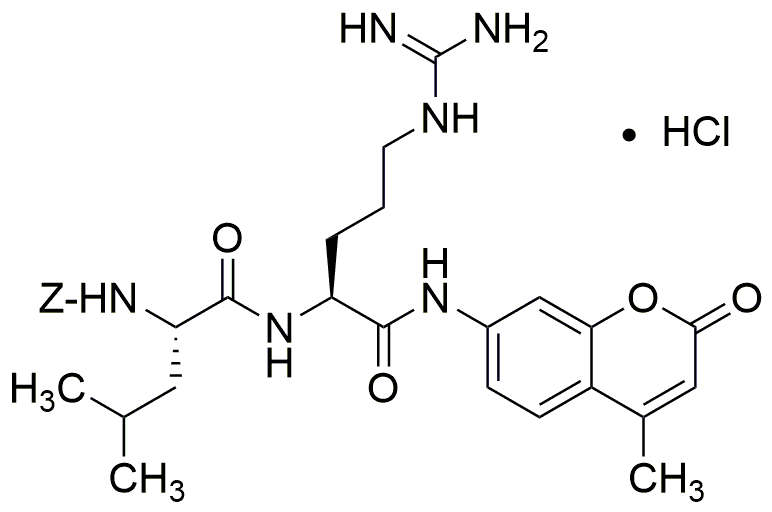Z-Leu-Arg-AMC·HCl is widely utilized in research focused on:
- Protease Activity Assays: This compound serves as a substrate in assays to measure protease activity, which is crucial for understanding various biological processes and diseases.
- Drug Development: It plays a significant role in the pharmaceutical industry for screening potential drug candidates that target specific proteases, aiding in the development of novel therapeutics.
- Biochemical Research: Researchers use it to study enzyme kinetics and mechanisms, providing insights into enzyme function and regulation in metabolic pathways.
- Diagnostics: This compound can be utilized in diagnostic tests to identify protease-related diseases, offering a valuable tool for early detection and treatment strategies.
- Academic Studies: It is commonly used in educational settings for teaching biochemistry and molecular biology, helping students understand enzyme-substrate interactions and their implications in health and disease.
General Information
Properties
Safety and Regulations
Applications
Z-Leu-Arg-AMC·HCl is widely utilized in research focused on:
- Protease Activity Assays: This compound serves as a substrate in assays to measure protease activity, which is crucial for understanding various biological processes and diseases.
- Drug Development: It plays a significant role in the pharmaceutical industry for screening potential drug candidates that target specific proteases, aiding in the development of novel therapeutics.
- Biochemical Research: Researchers use it to study enzyme kinetics and mechanisms, providing insights into enzyme function and regulation in metabolic pathways.
- Diagnostics: This compound can be utilized in diagnostic tests to identify protease-related diseases, offering a valuable tool for early detection and treatment strategies.
- Academic Studies: It is commonly used in educational settings for teaching biochemistry and molecular biology, helping students understand enzyme-substrate interactions and their implications in health and disease.
Documents
Safety Data Sheets (SDS)
The SDS provides comprehensive safety information on handling, storage, and disposal of the product.
Product Specification (PS)
The PS provides a comprehensive breakdown of the product’s properties, including chemical composition, physical state, purity, and storage requirements. It also details acceptable quality ranges and the product's intended applications.
Certificates of Analysis (COA)
Search for Certificates of Analysis (COA) by entering the products Lot Number. Lot and Batch Numbers can be found on a product’s label following the words ‘Lot’ or ‘Batch’.
*Catalog Number
*Lot Number
Certificates Of Origin (COO)
This COO confirms the country where the product was manufactured, and also details the materials and components used in it and whether it is derived from natural, synthetic, or other specific sources. This certificate may be required for customs, trade, and regulatory compliance.
*Catalog Number
*Lot Number
Safety Data Sheets (SDS)
The SDS provides comprehensive safety information on handling, storage, and disposal of the product.
DownloadProduct Specification (PS)
The PS provides a comprehensive breakdown of the product’s properties, including chemical composition, physical state, purity, and storage requirements. It also details acceptable quality ranges and the product's intended applications.
DownloadCertificates of Analysis (COA)
Search for Certificates of Analysis (COA) by entering the products Lot Number. Lot and Batch Numbers can be found on a product’s label following the words ‘Lot’ or ‘Batch’.
*Catalog Number
*Lot Number
Certificates Of Origin (COO)
This COO confirms the country where the product was manufactured, and also details the materials and components used in it and whether it is derived from natural, synthetic, or other specific sources. This certificate may be required for customs, trade, and regulatory compliance.


